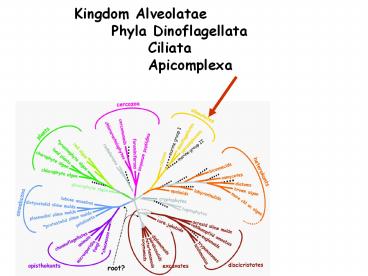Kingdom Alveolatae - PowerPoint PPT Presentation
1 / 15
Title: Kingdom Alveolatae
1
- Kingdom Alveolatae
- Phyla Dinoflagellata
- Ciliata
- Apicomplexa
2
Aveolates
Protists with tubulocristate mitochondria Series
of sacs or alveoli underneath cell membranes
http//tolweb.org/tree?groupAlveolatescontgroup
Eukaryotes
3
Dinoflagellates
- Unicellular protists
- Many photosynthetic important primary producers
in aquatic systems - Some produce own light (bioluminescence)
- Known to produce neurotoxins (red tide)
4
- Transverse flagellum encircles the body
- Longitudinal flagellum oriented perpendicular to
the transverse flagellum - Spiral to their swimming motion
http//www.geo.ucalgary.ca/macrae/palynology/dino
flagellates/theca.gif
5
Ciliates
- Complex unicellular organisms
- More than 7000 known species
- Heterotrophic organisms, live in environments
with moisture
6
- Two types of nuclei
- Micronucleus contains chromosomes, with two
copies of each chromosome - Macronucleus contains genetic material in the
form of short pieces of DNA - At cell division, the micronuclei divide through
mitosis, while in most ciliates the macronucleus
simply pinches apart into two
7
- Asexually- the micronucleus undergoes mitosis,
while the macronucleus pinches apart into two. - Sexually- conjugation,often induced by lack of
food. Opposite mating types come close together,
forming cytoplasmic bridge. Micromuclei divide by
meiosis, the macronuclei disintegrate, and the
conjugating cells exchange haploid micronuclei
over the cytoplasmic connection. They then
separate, reform new macronuclei from their
micronuclei, and divide.
8
Apicomplexans
- More than 5000 species, almost entirely parasitic
- Have apical complex of microtubules
- left over chloroplasts
http//www.tulane.edu/wiser/protozoology/notes/ap
i.html
9
- Generalized life cycle--gt
- infective stage (sporozoite) enters host cell
- divides to form numerous merozoites
- Some merozoites become into sexually reproductive
cells (gamonts) - Gamonts join in pairs to form gamontocyst
- Within the gamontocyst, gamonts divide to form
gametes - Pairs of gametes then fuse to form zygotes
- Zygotes give rise by meiosis to new sporozoites
Enter here
http//www.tulane.edu/wiser/protozoology/notes/ap
i.html
10
Causative Agent of Malaria
The life cycle of the parasite Plasmodium
falciparum aInfected mosquito feeds on a human,
injects the parasites in their sporozoite form,
travel to the liver, produce merozoites which
invade red blood cells and multiply (trophozoite
stage). Some merozoites develop into gametocytes.
bMosquito bites infected human, takes up blood
containing gametocytes, which develop into
gametes. Gametes fuse in the insect's gut to form
a zygote. Zygote develops into ookinete, which
crosses the wall of the gut and forms a
sporozoite-filled oocyst. Oocyst bursts,
sporozoites move to mosquito's salivary glands .
http//www.sanger.ac.uk/PostGenomics/plasmodium/p
resentations/plasmodium_lifecycle.shtml
11
Toxoplasma gondii
- Cat intestinal parasite
- Normal intermediate host is the rat
- Infected rats lose their natural fear of cats
increasing the chance that the parasite will move
on to another cat - Also parasitizes humansdangerous to the fetus of
pregnant women and to people with weakened immune
systems
12
(No Transcript)
13
An introduction to the phyla of the HETEROKONTAE
14
PHYLA OF THE HETEROKONTAE
- OPALINIDA NP
- LABYRINTHULAMORPHA NP
- BICOECIDA NP
- OOMYCOTA NP
- CHRYSOPHYTA
- RAPHIDIOPHYTA
- XANTHOPHYTA
- EUSTIGMOPHYTA
- PHAEOPHYTA
- BACILLARIOPHYTA
15
Heterokontae
- Synapomorphy- tripartite tubular hairs on their
flagella (basal section, a tubular shaft, and one
or more terminal hairs) - lost in some groups
- Tubulocristate mitochondria
- Dimorphic flagella
- Tinsel flagellum
- Whiplash flagellum
tripartite tubular hairs
Hollow mastigonemes

